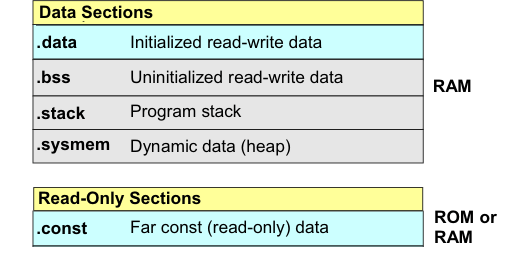SPRAC71B February 2019 – October 2023
- 1
- 1 Introduction
- 2 Data Representation
-
3 Calling Conventions
- 3.1 Call and Return
- 3.2 Register Conventions
- 3.3 Argument Passing
- 3.4 Return Values
- 3.5 Structures and Unions Passed and Returned by Reference
- 3.6 Conventions for Compiler Helper Functions
- 3.7 Prolog and Epilog Helper Functions
- 3.8 Scratch Registers for Functions Already Seen
- 3.9 Interrupt Functions
- 4 Data Allocation and Addressing
- 5 Code Allocation and Addressing
- 6 Helper Function API
-
7 Standard C Library API
- 7.1 About Standard C Libraries
- 7.2 Reserved Symbols
- 7.3 <assert.h> Implementation
- 7.4 <complex.h> Implementation
- 7.5 <ctype.h> Implementation
- 7.6 <errno.h> Implementation
- 7.7 <float.h> Implementation
- 7.8 <inttypes.h> Implementation
- 7.9 <iso646.h> Implementation
- 7.10 <limits.h> Implementation
- 7.11 <locale.h> Implementation
- 7.12 <math.h> Implementation
- 7.13 <setjmp.h> Implementation
- 7.14 <signal.h> Implementation
- 7.15 <stdarg.h> Implementation
- 7.16 <stdbool.h> Implementation
- 7.17 <stddef.h> Implementation
- 7.18 <stdint.h> Implementation
- 7.19 <stdio.h> Implementation
- 7.20 <stdlib.h> Implementation
- 7.21 <string.h> Implementation
- 7.22 <tgmath.h> Implementation
- 7.23 <time.h> Implementation
- 7.24 <wchar.h> Implementation
- 7.25 <wctype.h> Implementation
-
8 C++ ABI
- 8.1 Limits (GC++ABI 1.2)
- 8.2 Export Template (GC++ABI 1.4.2)
- 8.3 Data Layout (GC++ABI Chapter 2)
- 8.4 Initialization Guard Variables (GC++ABI 2.8)
- 8.5 Constructor Return Value (GC++ABI 3.1.5)
- 8.6 One-Time Construction API (GC++ABI 3.3.2)
- 8.7 Controlling Object Construction Order (GC++ ABI 3.3.4)
- 8.8 Demangler API (GC++ABI 3.4)
- 8.9 Static Data (GC++ ABI 5.2.2)
- 8.10 Virtual Tables and the Key function (GC++ABI 5.2.3)
- 8.11 Unwind Table Location (GC++ABI 5.3)
-
9 Exception Handling
- 9.1 Overview
- 9.2 PREL31 Encoding
- 9.3 The Exception Index Table (EXIDX)
- 9.4 The Exception Handling Instruction Table (EXTAB)
- 9.5 Unwinding Instructions
- 9.6 Descriptors
- 9.7 Special Sections
- 9.8 Interaction With Non-C++ Code
- 9.9 Interaction With System Features
- 9.10 Assembly Language Operators in the TI Toolchain
- 10DWARF
- 11ELF Object Files (Processor Supplement)
- 12ELF Program Loading and Linking (Processor Supplement)
- 13Build Attributes
- 14Copy Tables and Variable Initialization
- 15Revision History
4.1 Data Sections and Segments
In a relocatable object file output by the compiler or assembler, variables are allocated into sections using default rules and compiler directives. A section is an indivisible unit of allocation in a relocatable file. Sections often contain objects with similar properties. Various sections are designated for data, depending on whether the section is initialized, whether it is writable or read-only, how it will be addressed, and what kind of data it contains.
Conventions for placement of static variables into sections and for how they are addressed are covered in Section 4.4.2.
The linker combines sections from object files to form segments in an ELF load module (executable ). A segment is a continuous range of memory allocated to a load module, representing part of the execution image of the program.
A load module may contain one or more data segments, into which the linker allocates stack, heap, and static variables. Items may be grouped into a single segment or multiple segments, subject only to these restrictions:
- Within a segment, initialized data must precede uninitialized data. This is a structural constraint of ELF.
- Any additional restrictions imposed by the platform-specific conventions.
The run-time environment can dynamically allocate or resize uninitialized data segments, to allocate space for items such as the stack and heap.
Figure 4-1 shows the data sections defined by the ABI, and an abstract mapping of sections into segments. The mapping is only representative; the specific configuration may vary by platform or system. Initialized sections are shaded blue; uninitialized sections are shaded gray.
 Figure 4-1 Data Sections and Segments (Typical)
Figure 4-1 Data Sections and Segments (Typical)The .const section contains read-only constants. The .const section may be located in read-only memory, and may be addressed using absolute addressing.
The .data section contains initialized read-write data.
The .bss section contains uninitialized read-write data.
Additional special sections that can be placed by the linker command file are listed in Section 11.3.5.